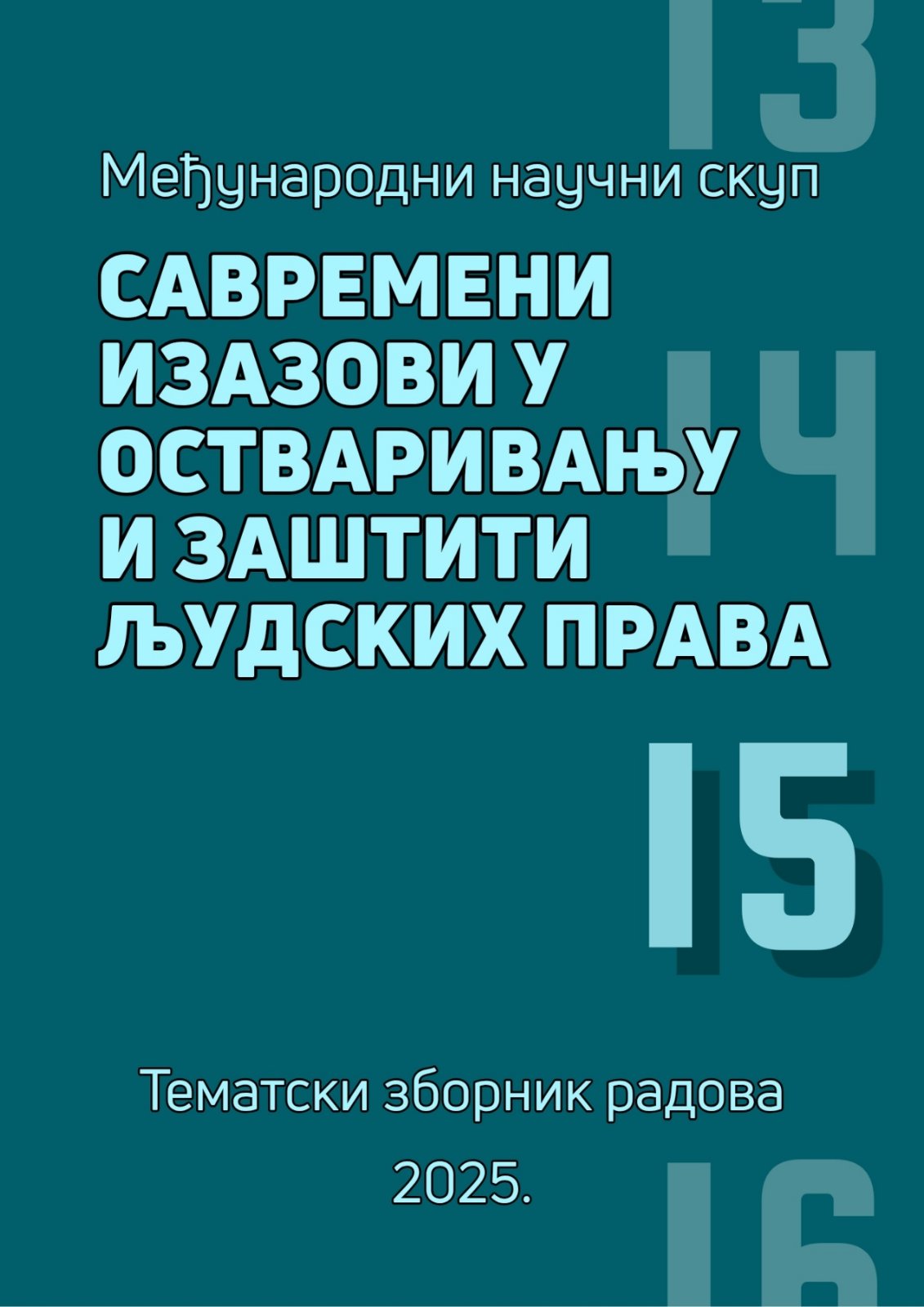АКТ О ВЕШТАЧКОЈ ИНТЕЛИГЕНЦИЈИ ЕВРОПСКЕ УНИЈЕ И САВРЕМЕНИ ИЗАЗОВИ У ОСТВАРИВАЊУ И ЗАШТИТИ ЉУДСКИХ ПРАВА
##plugins.pubIds.doi.readerDisplayName##:
https://doi.org/10.63177/mns.2025.02Кључне речи:
вештачка интелигенција, заштита људских права, Акт о вештачкој интелигенцији, антидискриминационе одредбе, савремени изазови.Сажетак
Акт о вештачкој интелигенцији (Акт о ВИ) усвојен је у мају 2024. године и ступио је на снагу двадесет дана од објављивања у Службеном листу ЕУ, 12. јула 2024. Почеће да се примењује у потпуности од 2. августа 2026. године. Акт о ВИ представља прву свеобухватну уредбу на свету о ВИ. Циљ Акта је да осигура да ВИ која се развија и користи у ЕУ буде поуздана и да обезбеди мере за заштиту основних људских права. Рад настоји на сагледа одредбе Акта о ВИ кроз призму савремених изазова у остваривању и заштити људских права. Најпре су у раду размотрене најзначајније одребе Акта о ВИ које се односе на системе ВИ. Посебна пажња посвећена је системима ВИ високог ризика, будући да су такви системи најизазовнији у контексту остваривања и заштите људских права. Након тога су анализиране антидискриминационе одредбе у Акту о ВИ, тачније њихов утицај на националне законодавне оквире држава чланица ЕУ. Будући да је уредба, као акт секундарног законодавства, директно применљива, ступа на снагу након објављивања у Службеном листу ЕУ. Дакле, није потребан никакв акт унутрашњег, националног права којима се одредбе и циљеви уредбе транспонују у национални правни поредак. Осим тога, и земље кандидати за чланство у ЕУ имају обавезу да националне регулаторне оквире ускладе са правним тековинама ЕУ током процеса приступања. Стога се очекује да ће Акт о ВИ имати велики утицај и на регулисање примене ВИ у земљама кандидатима за чланство у ЕУ, укључујући и Републику Србију.
Референце
Аврамовић Д., Јованов И. 2023. Судијска (не)пристрасност и вештачка интелигенција. Страни правни живот 2, стр. 161–177. Доступно на: https://doi.org/10.56461/SPZ_23201KJ (10. 4. 2025);
Андоновић С. 2020. Стратешко-правни оквир вештачке интелигенције у упоредном праву. Страни правни живот 3, стр. 111–123. Доступно на: https://doi.org/10.5937/spz64-28166 (10. 4. 2025);
Bianchiani N., Ancona L. 2023. Artificial Intelligence: Europe must start dreaming again. Schuman Paper 728. pp. 1–9;
Veale M., Zuiderveen Borgesius F. 2021. Demystifying the Draft EU Artificial Intelligence Act. Computer Law Review International 4, pp. 97–112.
Glintić M. 2024. Insurance market response to challenges imposed by Artificial Intelligence. In: Glintić M., Obradović D., Causation of Damages, Damage Compensation and Insurance. Belgrade: Institute of Comparative Law, pp. 33–49;
Živković A. 2024. Computer programs legal protection framework with special reference to Artificial Intelligence ChatGPT. Strani pravni život 3, pp. 317–338. DOI: https://doi.org/10.56461/SPZ_24301KJ
Korać, V., Prlja, D., Gasmi, G. 2021. Challenges brought on by Artificial Intelligence. Archaeology and Science 17, pp. 159–165. DOI: https://doi.org/10.18485/arhe_apn.2021.17.10
Korać, V., Prlja, D., Gasmi, G. 2023. European Approach to Artificial Intelligence. Archaeology and Science 19, pp. 209–216. DOI: https://doi.org/10.18485/arhe_apn.2023.19.14
Korać, V., Prlja, D., Gasmi, G. 2023. European Approach to Artificial Intelligence. Archaeology and Science 19, pp. 209–216. DOI: https://doi.org/10.18485/arhe_apn.2023.19.14
Lück-Matz, N. 2011. Framework Agreements. In: Oxford Public International Law. Available at: https://opil.ouplaw.com/display/10.1093/law:epil/9780199231690/ law-9780199231690-e703#:~:text=A%20framework%20agreement%20can%20 be,agreements%20between%20the%20parties%2C%20usually (8. 4. 2025).
Mihajlović А., Ćorić В. 2024. Artificial Intelligence and discrimination – strengths and weaknesses of the current European anti-discrimination legal framework. In: Kostić J., Rodina A., Russo T., Regional Law Review. Belgrade: Institute of Comparative Law, pp. 9 – 29, DOI: https://doi.org/10.56461/iup_rlrc.2024.5.ch2
Samman T., de Vanssay B. 2024. What to take away from the European law on Artificial Intelligence, Schuman Paper 757, pp. 1–7;
Stanić М., Tintor Lj. 2024. Human rights and Artificial Intelligence – International Public Law and Constitutional Aspects. In: Kostić J., Rodina A., Russo T., Regional Law Review. Belgrade: Institute of Comparative Law, pp. 169–178, DOI: https://doi.org/10.56461/iup_rlrc.2024.5.ch2
Ceranic Perisic Ј. 2025. Digital transformation: Regulation of Artificial Intelligence in the European Union. In: Kellerhals K., Baumgartner T., Ademi F, 15th Network Europe Conference European Integration in Times of Security Challenges. Zurich: EIZ Publishing, pp. 147–164, DOI: https://doi.org/10.36862/eiz-784
Howells G. 2020. Protecting Consumer Protection Values in the Fourth Industrial Revolution. Journal of Consumer Policy 43, pp. 145 –175;
Consolidated version of the Treaty on the Functioning of the European,
OJ L 115, of 9 May 2008.
Regulation (EU) 2016/679 of the European Parliament and of the Council of 27 April 2016 on the protection of natural persons with regard to the processing of personal data and on the free movement of such data, and repealing Directive 95/46/EC, OJ L 119 of 4 May 2016.
Regulation (EU) 2024/1689 of the European Parliament and of the Council of 13 June 2024 on laying down harmonised rules on artificial intelligence and amending Regulations (EC) No 300/2008, (EU) No 167/2013, (EU) No 168/2013, (EU) 2018/858, (EU) 2018/1139 and (EU) 2019/2144 and Directives 2014/90/EU, (EU) 2016/797 and (EU) 2020/1828 (Artificial Intelligence Act), OJ L 2024/1689, 12. July 2024;
White Paper on Artificial Intelligence: A European approach to excellence and trust of 19 February 2020, COM (2020) 65 final;
Доступно на: https://www.oecd.org/en/publications/explanatory-memorandum-on-the-updated-oecd-definition-of-an-ai-system_623da898-en.html (1. 4. 2025);
Доступно на: https://www.coe.int/en/web/artificial-intelligence/the-framework-convention-on-artificial-intelligence (1. 4. 2025);
Доступно на: https://digital-strategy.ec.europa.eu/en/policies/ai-pact (5. 4. 2025.).






